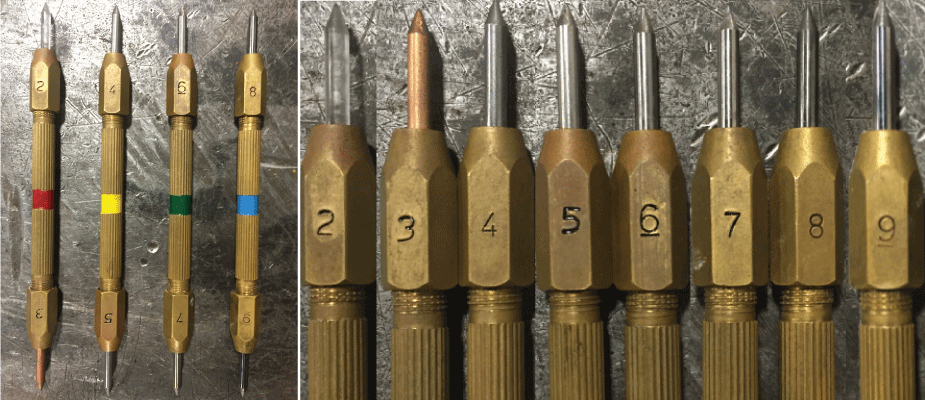If you’re new to polishing or want better results, we’ve put together 5 things the Pros do that will ensure efficiency and desired finish if followed accordingly.
*Note: Although this is blog is written with contractors in mind, if you’re a rental house/ hire depot owner or dealer, knowing these tips will help you to better understand the polishing process so you’ll be better equipped to assist your customers in selecting the appropriate equipment and tooling for their job.
1) Determine the Hardness
The first thing you’ll want to do is determine the hardness of the concrete being polished. This is the most important factor in determining the type of grit and bond of diamond tooling to use.
The most cost effective way to figure out the hardness of the concrete effectively, is to use a scratch test kit based on the Mohs scale of relative mineral hardness. This kit is readily available for purchase online, and can be relatively inexpensive. It consists of four double-ended, color coded picks, that have 8 points made of different materials, representing the Mohs’ hardness scale (2,3,4,5,6,7,8, and 9).

It works by scratching the surface of the concrete with the various picks of different hardness. For example, if a number 6 pick scratches the concrete, but a number 5 pick doesn’t, then your material’s hardness is 5.5.
This scratch test makes it easy to determine where the concrete ranks on the Mohs hardness scale, which will help you choose the most efficient and cost-effective tooling for the job. Basically you want to choose a bond opposite of soft and hard- If you are polishing hard concrete, you’ll want a soft bond so that the diamonds are easily exposed, and if you’re polishing soft concrete, you’ll want to use harder bonds and so on. This will ensure that there will be no unnecessary wear that will cause you to burn through your tooling quicker.
2) REPAIR CHIPS, CRACKS AND SPALLS
The reason for repairing the concrete before polishing is to make the surface look as close to flawless as possible. Although getting an identical, flawless patch isn’t guaranteed, there are different forms of repair that can be used for the various forms of damage, to get as close of a match to the surrounding concrete as possible.
- For small or shallow chips, divots and spalls, using cement- based patching mixtures is your best bet.
- For minor damage you can use skim-coat material used for overlaying concrete floors.
- For damage 1/4 inch (approximately 6.35 mm) or greater, or damage that covers larger areas, it is best to use anchoring or hydraulic cement, or a self-leveling overlay.
- Static Cracks are hairline cracks that only affect the surface of the concrete. Usually, this type of crack isn’t a big deal and doesn’t require much attention. Many people will choose to leave them for a decorative touch. However, if you’re looking to hide them, you can apply a tinted urethane skim coat.
- Moving Cracks can be more of an issue and need to be repaired before polishing. You’ll need to use a V-grooved diamond blade to root out the crack. You’ll then need to clean out the crack with a shop vac and then blow away any dust that may be left with compressed air. To fill, you can use a semi-rigid polyurea, or use the appropriate “grind and fill” repair material before polishing
If you’re unsure about what to use, make sure to reach out to a professional who is seasoned in concrete floor repair.
3) REPAIR JOINTS
There are three main types of joints that you’ll run into, that may need to be repaired before you begin polishing. They are, Contraction, Isolation and Construction joints.
Contraction Joints (also known as control joints) are placed in the wet concrete to help control random cracking, due to expansion and shrinkage.
Isolation Joints isolate the slab of concrete something else, like a wall, drainpipe, and column etc. These joints are formed before the concrete is poured.
Construction Joints are placed in-between slab pours. You generally don’t pour the entire slab at once. Bulkheads made of wood, steel, plastic, or precast concrete are often used as screed rails, and can also function as construction joints.
You’ll want to clean out the joints and then fill them fully with a polyurea or semi-rigid epoxy. Repairing damaged joints will ensure an aesthetically pleasing finish, but will also lessen the chance of the joint edges chipping or spalling in the future.
4) CLEAN THE CONCRETE FLOOR
If you’re polishing older concrete most likely you’ll need to do some cleaning before you begin polishing. If the concrete has any oil stains, you’ll want to remove them beforehand because they will impede the permeation of the densifier, stains, and dyes, resulting in color variations.
There are a couple ways to remove oil stains. There are a few de-greasers and detergents on the market that can be used for removing light or small oil stains. For heavier stains, there are various blends of dry absorbent clay that work well for extracting more difficult oil and dirt stains from concrete.
Also it is important to make sure that any adhesives on the concrete, used for previous flooring, is removed completely before you begin polishing. This will ensure an even finish. If it hasn’t already been done for you, then depending on the leftover material, you can use a floor scraper or grinder for removal.
5) SELECT THE RIGHT EQUIPMENT AND TOOLING
Like we talked about above, you’ll want to choose a bond opposite of the concrete hardness. If you are polishing hard concrete, you’ll want a soft bond so that the diamonds are easily exposed, if you’re polishing medium concrete, you can use medium bonds, and if you’re polishing soft concrete, you’ll want to use harder bonds and so on. This will ensure there is no unnecessary wear that will cause you to burn through your tooling quicker, as well as help to achieve an even finish.
Most Polishing and Grinding equipment manufacturers can also supply you with the appropriate tooling. If you’re unsure of what to use, make sure to ask the equipment manufacturer or dealer so you don’t end up wasting your time and money with the wrong tooling.
If you follow these easy 5 steps effectively before you begin polishing, you’ll end up with a professional and possibly flawless looking finish.
If you have any other questions about Polishing, feel free to reach out and one of our product specialists would be happy to help.


 By
By 